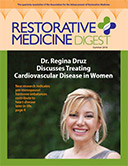Genetics focuses on single genes or sequence variations in a small group of genes whose presence is associated with an increased risk of developing a particular health disorder. For example, familial hypercholesterolemia, which is a risk factor for developing coronary artery disease, is associated with the presence of sequence variations in a distinct group of genes including LDLR (which encodes for the low-density lipoprotein receptor) or APOB (which encodes for apolipoprotein B). Information transmitted through DNA is obviously important, but it is interesting to reflect that family lineage can also impact behavioral and lifestyle patterns that are transmitted through generations. While mutations in single genes play a significant role in familial and rare forms of cardiovascular disease (CVD), that association accounts for only a small percentage of total CVD observed at a population level and pertains more to people with early onset CVD.1
By comparison, genomics attempts to study genetic and epigenetic molecular sequences to understand their combined effects on downstream biology in health and disease. The term CVD refers to a group of disorders that includes coronary artery disease (also known as ischemic heart disease), cardiomyopathies, arrhythmias, and heart failure. Complex disorders such as CVD generally arise from the collective impact of multiple genetic, environmental, and epigenetic factors.2 Genomics, therefore, is a promising field for establishing risk factors and, potentially, personalized treatment approaches.
Accounting for the influence of genes, varied phenotypes, and environmental factors is no easy task, however.3 Cardiomyopathies, for example, are a major cause of heart failure, and almost 100 cardiomyopathy-associated genes have been identified. Heart failure, however, as an end process constitutes a syndrome that can have multiple contributory factors, including coronary artery disease, valvular heart disease, and infections, or it can have congenital or hereditary causes.4 Because the processes that result in heart failure are so varied, a full elaboration of the genetic picture of heart failure is still unclear.5 Unfortunately, despite advances in genomics research, heart failure continues to be a growing epidemic worldwide, likely in large part due to the rise in degenerative inflammatory conditions associated with aging populations.6
Enormous amounts of genomic data are becoming increasingly available, allowing scientists to calculate which of hundreds or even thousands of genomic variants are more frequently found in groups of people with a specific disease, compared to groups of people without that disease. The extent of genetic complexity involved in most of the health conditions examined, including CVD, has been, perhaps unsurprisingly, more than expected.7 However, increasingly sophisticated genomic techniques are becoming more capable of providing predictive risk scores with potential clinical relevance to people on varying polygenic trajectories for CVD, such as, for example, those with ischemic heart disease.8
A growing body of evidence shows that susceptibility to adult-onset CVD begins in early life, even in utero,9 presumably as a result of epigenetic dysregulation.10 The public health consequences of administering genomic risk analysis at a young age, particularly if nutritional, behavioral, and lifestyle interventions are not given priority over pharmacological drugs, is certainly something to be watchful about. Furthermore, signs, symptoms, and causes of coronary artery disease, myocardial infarction, and heart failure can differ by sex,11 with female patients getting diagnosed later, even though they often present with worse diastolic function and more severe heart failure symptoms than male patients.12 Hopefully, the chronic underrepresentation of female participants in clinical studies of cardiovascular disease is not echoed in the big data sets gathered and used in genomic analyses.
It is important to remember that any estimation of CVD risk based on genomic analysis is relative and not absolute. In addition, for polygenic risk scores to be valid, the data they are derived from must be complete and relevant. In regard to that, most genomic studies so far have a historic lack of diversity and are based on individuals of European ancestry.13 The applicability to people of non-European ancestry may be limited. The future of helpful predictive risk scores for cardiovascular health is promising, but these caveats, at present, persist.
To learn more about Cardiovascular Genetics, register for Restorative Medicine’s Certification in Cardiology Principles virtual live program, launching March 2024.
References
- https://www.ahajournals.org/doi/full/10.1161/01.cir.0000437913.98912.1d
- https://www.frontiersin.org/articles/10.3389/fcvm.2018.00060/full
- https://academic.oup.com/clinchem/article/58/1/113/5620673
- https://www.ncbi.nlm.nih.gov/pmc/articles/PMC5933969/
- https://www.frontiersin.org/articles/10.3389/fcvm.2021.646816/full
- https://www.ncbi.nlm.nih.gov/pmc/articles/PMC4868779/
- https://www.nature.com/articles/s41576-018-0018-x
- https://www.ncbi.nlm.nih.gov/pmc/articles/PMC6176870/
- https://pubmed.ncbi.nlm.nih.gov/15850633/
- https://www.nature.com/articles/pr20136
- https://www.ncbi.nlm.nih.gov/pmc/articles/PMC8484093/
- https://www.nature.com/articles/s41598-021-88256-x
- https://www.ncbi.nlm.nih.gov/pmc/articles/PMC7614889/
